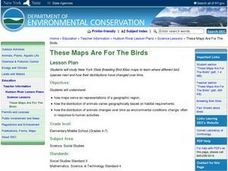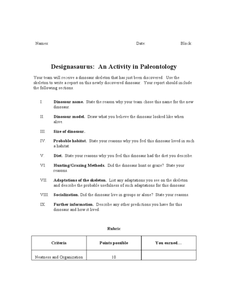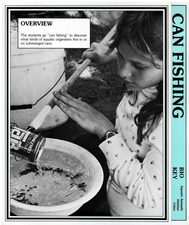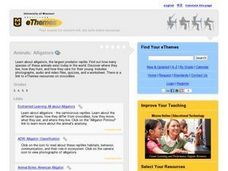Curated OER
These Maps are for the Birds
Students identify and study New York State Breeding Bird Atlas maps to learn where different bird species nest and how their distributions have changed over time. They also identify how maps serve as representations of a geographic...
Curated OER
Striking a Balance
Students simulate animals in a food chain. In this food chain lesson plan, students are identified as grasshoppers, frogs or hawks. Popcorn is spread across a lawn and students are given baggies (stomachs) and colored sashes to identify...
Curated OER
Designasaurus: An Activity in Paleontology
For this dinosaur worksheet, learners are given a dinosaur skeleton and they work in teams to report about a "newly discovered dinosaur". They create and include it's name, a model of it, its size, the habitat it lived in, its diet, its...
Curated OER
For The Birds
Students observe birds building their nests. In this habitat lesson, students develop a Best Building Supply Bag and record how the birds build their nests. Students keep a Field Journal.
Curated OER
Move it Like An Animal
Students investigate how animals move. In this animals lesson plan, students use pictures of animals and demonstrate how each of them moves from place to place.
Curated OER
Deserts: How Do You Define One?
Second graders identify what constitutes as a desert by reading a habitat checklist. In this environment lesson plan, 2nd graders read a nature website to discover facts about the desert and where they are located. Students utilize art...
Curated OER
Animal Colors and Shapes
Learners investigate the natural characteristics of animals by completing a coloring activity. In this animal properties lesson, students investigate the reasons different animals have specific colors, and how it is essential for their...
Curated OER
Adapt a Poem to a Wetland Habitat
In this adapt a poem to a wetland habitat worksheet, students read the poem "Over in the Meadow", then write 5 new stanzas using that format about a wetland or a swamp and its animals. This page has several links to helpful websites.
Curated OER
Guess Who? Coral
Fourth graders identify and group coral formations. In this coral identification lesson, 4th graders examine coral pictures, discuss vocabulary, and provide similarities and differences in the growth formations.
Curated OER
Acorns
Students experience hoarding food for winter. For this squirrel lesson, students simulate hoarding behavior as either a red or gray squirrel. Students play a game called Winter Survival and discover how squirrels survive through the...
Curated OER
Can Fishing
Fifth graders investigate aquatic organisms. In this fishing lesson, 5th graders use can-fishing rigs to observe animals in their natural habitat. Students consider ways to solve a problem and discuss their findings.
Curated OER
What does 'Endangered' mean?
Students discuss a variety of teacher led discussion questions about what makes an animal endangered. They take a short field trip to an open area and set a boundary for each child for them to either write or draw about how the location...
Curated OER
Oysters Are Habit Forming!
Students examine the relationships within a salt marsh habitat. In this habitat lesson, students examine the various kinds of symbiotic relationships in a salt marsh habitat.
Curated OER
Salt Marshes - Biotic Perspectives
The vocabulary used in this presentation on salt marshes makes it most appropriate for high school or college level ecology classes. The content, however, is relatively simple; It introduces the flora and fauna of this type of ecosystem....
Curated OER
Hole Homes
Students make predictions regarding appearances of animal homes through observation, comparison, and evaluation of a habitat.
Curated OER
Arctic Animals
In this animal habitats worksheet, students study the various pictures of the animals and then make a cross over the animals that don't live in the arctic with the polar bear.
Curated OER
Variation
For this animal habitat worksheet, students read the clues about the animal environments. Students then write or draw each of the animals in the right space. Students find the habitats for trout, a bird, a human, and an earthworm.
Curated OER
Forest Animals
Students explore forest animals and their habitats. In this animal habitat lesson, students draw a forest on white paper and glue pictures of animals that roam in the forest
Curated OER
Where Do You Fit In?
Students study habitats and then draw a picture of their own habitat which includes the location of food, water, and shelter, and the concept of space. then they cut their habitat in half and discuss how this would affect their lives.
Curated OER
The Invisible Zoo
Students explore how infrared images give biologists or zoologists detailed information on how warm-blooded and cold-blooded animals thermoregulate. They are introduced to infrared imaging technology and the information that such images...
Curated OER
Protect the Bats!
Students explore bat habitats. For this bat lesson, students discover the work of people trying to protect bat habitats. Students make posters that promote the message of saving bats.
Curated OER
Saving Big Cats from Extinction
Students explore extinction. In this biology and environmental science lesson, students define extinction, identify what living things need to survive, and create a persuasive poster about "saving the big cats" using a desktop...
Curated OER
Animals: Alligators
Learners study alligators, discover their habitats, species and how they care for their young.
Curated OER
Reindeer Research
Students research reindeer habitats and purposes. They investigate the historical significance of reindeer and the Christmas holiday. Finally, they write a short fictional story about reindeer using the information from their research.
Other popular searches
- Elementary Science Habitats
- Life Science Habitats
- Ks2 Science Habitats
- Desert Habitats Science
- Esl Lessons Science Habitats
- Science Habitats Lesson

























